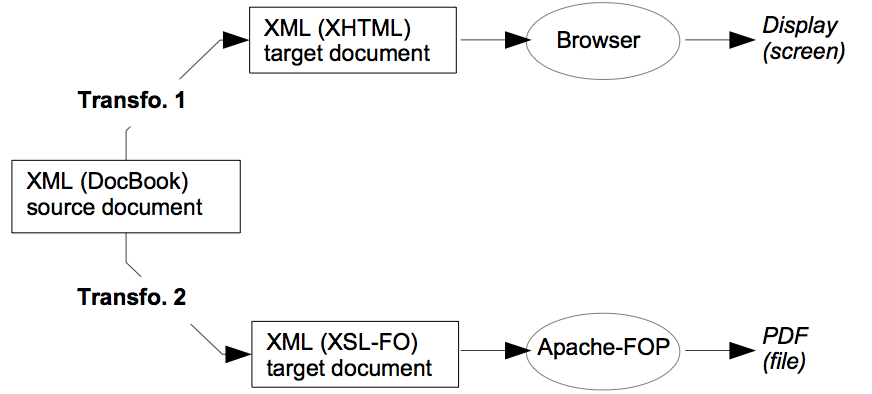Trees are everywhere in computers
- Trees live in central memory (as objects, with a
heavy use of pointers).
- In order to exchange trees over the Internet we need
a file-based (text) representation
also called serialization.
(For instance, program texts, using the concrete syntax of a programming language, are nothing more than
file-based representations of Abstract Syntax Trees - ASTs)
- XML is
- a uniform solution to the problem of
representing trees as text files;
- an Object-Oriented framework tfor representing
trees as objects (i.e. the Document Object Model - DOM).
Note that other popular solutions for the same problem exist, like JSON or YAML.
- a uniform solution to the problem of
representing trees as text files;
XML is about trees
-
Parsing
- Principle : converting a tree given as a text (from a
file or from the Net)
into an object of some programming language (Java, PHP, C++,...), which is then processed by an ordinary program.
- If the chosen format for the generated object is DOM,
then parsing is fully automated.
- Principle : converting a tree given as a text (from a
file or from the Net)
-
Specifying tree structure (Validation)
Any treament of a tree will be based on knowledge about the structure of that tree.
If the given tree fails to conform with the expected structure, the treatment results in error (syntax error...).
A way to reduce such errors is to check beforehand that the tree is syntactically correct,
- not only as XML,
- but also as regards the intended treatment (then the tree
is said to be valid).
Trees with the "same" structure build XML dialects - or XML-based languages.
Each language has its own use (semantics) provided by standard software - see below.
- not only as XML,
-
Transforming trees
(from one XML-based language to another).
Transforming an (unusable) source document into a usable one.
The success of XML is based on
- A world-wide consensus about technical details (W3C).
- A fast-growing number of XML-based languages
(dialects) : e.g. XHTML, SVG...
- So much so that some people define XML as
a metalanguage to design markup languages, i.e. text language where semantic and structure are added to the content
using extra "markup" information enclosed between angle brackets.
HTML is the most well-known markup language.
[libxml] - Some of those XML-dialects are dedicated to XML technology itself (e.g.
XSLTransform, XMLSchema)
- Almost all configuration files are now styled in XML instead of ad-hoc syntaxes (e.g.
make...)
- So much so that some people define XML as
- A massive set of tools
- for XML in general
- generic libraries such as libxml2 (originally
in C, but with a number of "bindings" for other languages)
- XML frameworks in virtually every programming
language (e.g. Java : JAXP, JAXB)
- generic libraries such as libxml2 (originally
in C, but with a number of "bindings" for other languages)
- for various XML languages e.g.
- Web browsers for
XHTML, SVG and others
- Apache-FOP for the XSL-FO dialect,
- Web browsers for
XHTML, SVG and others
- for XML in general
The present course
-
Five sessions
+ a final project (base for evaluation)
- XML syntax & XML namespaces
- Validation (XML Schemas and RNG Grammars)
- XPath
- Transforms-1
- Transforms-2
- Project
Basic toolkit : Eclipse XML perspective
-
Project theme
The report on the Java project written in DocBook
- DocBook is an XML language for writing printable
documents
(books or papers) as trees
(as a sequence of chapters, each cuapter containing title, paragraphs etc)
[Wikipedia]
- Various tools are available to transform DocBook
into
readable format (e.g. XHTML, pdf via XSL-FO)
- Example : Course notes on DocBook written in DocBook
- the XML-DocBook file
- the XHTML rendering
- the pdf version.
in the same way as the screen display is produced by the browser from the XML (in XHTML language) source code.

- DocBook is an XML language for writing printable
documents
(books or papers) as trees